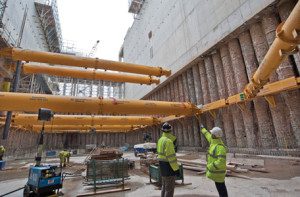GROUNDFORCE Shorco has used its new Super Mega Brace support system with integral hydraulic rams for the first time on a major project for the renewable energy sector.
The equipment was supplied to main contractor Clugston Construction for use in the construction of a concrete energy-from-waste fuel bunker situated on the Wilton International waste-to-energy site in Redcar, Teesside.
Clugston, together with process partner CNIM, is building the new plant which, when completed, will burn domestic waste supplied by Merseyside Waste as fuel to generate renewable energy.
The imported waste will be transported by train and stored in a huge concrete bunker prior to being burned to generate heat and power.
Construction of this concrete bunker has required the excavation of a 13m deep box structure below ground level.
The completed bunker is 50m long and 20m wide.
The walls of this bunker are lined with a series of contiguous concrete bored piles installed by specialist contractor P J Edwards with foundation design by engineer Byrne Looby.
Supporting these piled walls at such a depth has required a very strong and rigid temporary propping solution supplied by Groundforce’s major projects division.
“Until you’ve cast the reinforced concrete base slab, there’s a risk of the bottom of the piles ‘kicking in’ under the pressure of the ground behind them” explained Clugston’s chief engineer Ray Postolowsky.
So to prevent this happening, Groundforce provided temporary propping at the base of the excavation and another level of support higher up to satisfy the high deflection and stiffness requirements calculated by Clugston’s consulting engineer, Tata Steel Projects.
The upper level of the excavation is supported by two MP500 hydraulic props which are attached directly to the face of the concrete capping beam – a massive structure which is up to 5m thick in places.
The lower level was supported by three more MP500s which span across the width of the box, and four MP250 knee-braces, one spanning each corner of the rectangular excavation.
All of the props in the lower level bear against Groundforce’s Super Mega Brace beams which transfer the loads from the contiguous concrete piled retaining wall, so the lower level props can be removed when the base slab has been cast and the high level props can be removed when a bunker dividing wall has been constructed.
The Super Mega Brace is the strongest proprietary hydraulic brace in the industry and is ideal for large interceptor tanks, major structures and excavations subject to high lateral loads.
The modular hydraulic components are quick to assemble and lift into place.
Once in position, they are extended and hydraulically pre-loaded to support the lateral forces that will act upon them.
This project was designed by Tata Steel Projects using the latest Eurocodes and is one of the first fully Eurocode-compliant schemes that Groundforce’s major projects department has worked on.
Stiffness was a key factor in the design and so, rather than keep the props under hydraulic pressure, Groundforce was required to lock them off mechanically to ensure rigidity in the frame. The firm used specially-designed welded isolation plates to isolate the hydraulic element of the MP250 props, though not the larger MP500s.
“Our MP500s are a hybrid strut and as such they have much higher stiffness values due to their ability to self-isolate” added Adam Fletcher, major projects engineer with Groundforce.
This project is one of the first to use Groundforce’s new Super Mega Brace, its high section modulus and moment capacity allowing long, clear spans to keep the area clear of obstructions while Clugston continued excavating the bunker.
Additionally, Groundforce supplied its own real-time load monitoring system to constantly record lateral forces.
“With this system, we know if there are any changes in pressure which would give us warning of any likelihood of movement,” said Ray Postolowsky. “It takes all the guesswork out of it.”
Six of the nine props were fitted with the load monitoring device, as well as thermometers to register surface temperature fluctuations.










